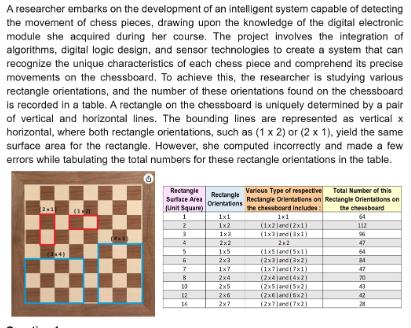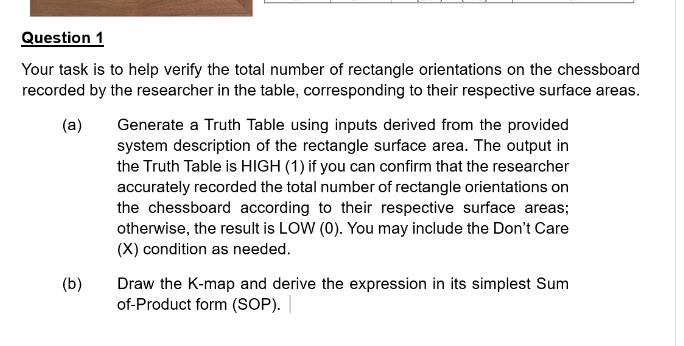Answered step by step
Verified Expert Solution
Question
1 Approved Answer
A researcher embarks on the development of an intelligent system capable of detecting the movement of chess pieces, drawing upon the knowledge of the


A researcher embarks on the development of an intelligent system capable of detecting the movement of chess pieces, drawing upon the knowledge of the digital electronic module she acquired during her course. The project involves the integration of algorithms, digital logic design, and sensor technologies to create a system that can recognize the unique characteristics of each chess piece and comprehend its precise movements on the chessboard. To achieve this, the researcher is studying various rectangle orientations, and the number of these orientations found on the chessboard is recorded in a table. A rectangle on the chessboard is uniquely determined by a pair of vertical and horizontal lines. The bounding lines are represented as vertical x horizontal, where both rectangle orientations, such as (1 x 2) or (2 x 1), yield the same surface area for the rectangle. However, she computed incorrectly and made a few errors while tabulating the total numbers for these rectangle orientations in the table. 01 Rectangle Surface Area (Unit Square) 1 2 7 B 10 12 26 Rectangle Orientations 1x1 1x2 1x2 2x2 1x5 2x3 1x7 2x4 2x5 2x6 2x7 Various Type of respective Total Number of this Rectangle Orientations on Rectangle Orientations on the chessboard include: the chessboard 64 1x1 (1x2(2x1) (1x3d(3x1) 2x2 (1x51an (5x1) (2x3 jand13x2) (1x7 and 7x1) (2x44x2) (2x51and15x2) (2x15x21 (2x71and17x2) 112 WebAE2ARE 47 64 M 47 43 42 28 Question 1 Your task is to help verify the total number of rectangle orientations on the chessboard recorded by the researcher in the table, corresponding to their respective surface areas. (a) (b) Generate a Truth Table using inputs derived from the provided system description of the rectangle surface area. The output in the Truth Table is HIGH (1) if you can confirm that the researcher accurately recorded the total number of rectangle orientations on the chessboard according to their respective surface areas; otherwise, the result is LOW (0). You may include the Don't Care (X) condition as needed. Draw the K-map and derive the expression in its simplest Sum of-Product form (SOP).
Step by Step Solution
There are 3 Steps involved in it
Step: 1
a To generate the Truth Table I will use the rectangle surface area as the input and compare it wi...
Get Instant Access to Expert-Tailored Solutions
See step-by-step solutions with expert insights and AI powered tools for academic success
Step: 2

Step: 3

Ace Your Homework with AI
Get the answers you need in no time with our AI-driven, step-by-step assistance
Get Started


